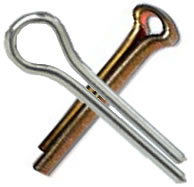
Cotter pins offer a simple and effective fastening solution. As shown in the adjacent photo, they consist of a narrow, U-shaped piece of metal.
Cotter pins are designed for use in rods or bolts. Assuming there’s a hole through the shank of a rod or bolt, you can secure it with a cotter pin. Placing a cotter pin through this hole and then bending the two prong-like ends will prevent the rod or bolt from falling out. Below are five fast facts about cotter pins.
#1) Also Known as Split Pins
Cotter pins are also known as split pins. This is a direct reference to their split installation. While available in different shapes and materials, all cotter pins are designed to be split during installation. Using a pair of pliers, you can pull or “split” the two prong-like ends apart.
#2) Not the Same as R-Clips
They may look similar, but cotter pins and R-clips aren’t the same. R-clips consist of an R-shaped piece of metal, whereas split pins consist of a U-shaped piece of metal. Aside from their shape, they also function differently. R-clips act like a spring. When you push an R-clip through a rod or bolt — the rod or bolt requires a hole as well — it will compress like a spring. Split pins, on the other hand, require bending, as they don’t compress like a spring.
#3) Available in Standard Sizes
You can find cotter pins in a variety of sizes. They are available in both metric and U.S. sizes. Like with other fasteners, sizes for cotter pins are standardized. Common diameter sizes (metric), for instance, include the following:
- 1.5 mm
- 2 mm
- 2.5 mm
- 3 mm
- 4 mm
- 5 mm
- 6 mm
#4) Hammer Lock Split Pins
While most split pins feature a traditional U-shaped design that requires nothing more than a pair of pliers to install, others require a hammer. They are known as hammer lock split pins. Hammer lock split pins are still placed through a rod or bolt. But to secure them in place, you’ll need to strike the head with a hammer.
#5) Single Use
Whether it’s a traditional or hammer lock split pin, you’ll typically need to replace it after using it. Most split pins are only intended for a single use. This is due to the fact that they are bent during installation. Using either a pair of pliers or a hammer, you’ll have to bend them after placing them through a rod or bolt.



